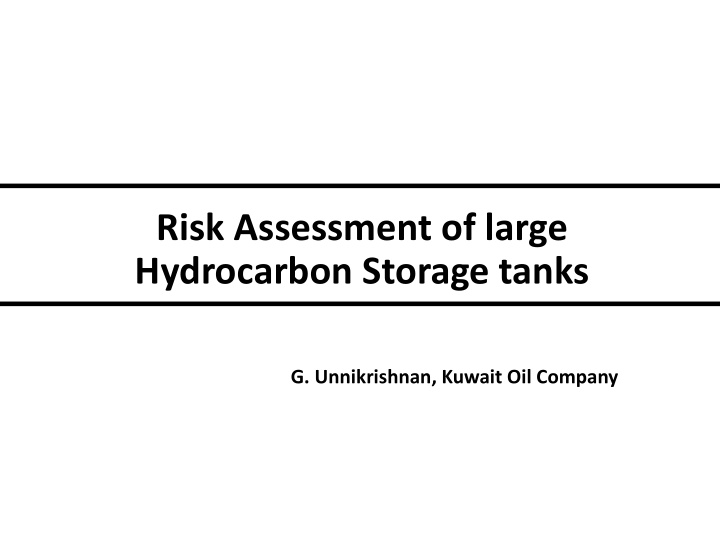



Risk Assessment of large Hydrocarbon Storage tanks G. Unnikrishnan, Kuwait Oil Company
What QRAs can tell Incident/failure Location Specific frequencies Individual Risk Identification Risk transects Measures Of incident of Risk scenarios Frequency – Fatalities (FN Consequences Impacts Curve)
Risk Contours Risk transect
ASSURANCE Project: Benchmarking exercises for QRA methods Variations in predicted frequencies of FN Curve defined levels of fatalities ranging between 2 and 4 orders of magnitude by different analysts .
Will QRAs would have predicted this ? Jaipur. India: 29 October 2009: 13 Buncefield. UK: 10 Dec 2005: San Juan. Puerto Rico: 23 Fatalities. Property Property damage, October 2009: Property damage, Environmental Environmental impact damage, Environmental impact impact
Buncefield. Why it happened There should be a clear understanding of major accident risks and the safety critical equipment and systems designed to control them. Time and resources for process safety should be made available. There should be systems and a culture in place to detect signals of failure in safety critical equipment and to respond to them quickly and effectively. There should be effective auditing systems in place which test the quality of management systems and ensure that these systems are actually being used on the ground and are effective. At the core of managing a major hazard business should be clear and positive process safety leadership with top management involvement and competence to ensure that major hazard risks are being properly managed.
Buncefield. Recommendations (20) Systematic assessment of Safety Integrity Level requirements Protecting against loss of containment using high integrity systems Engineering against escalation of loss of primary containment Engineering against escalation of loss of secondary and tertiary containment Operating with high reliability organizations Delivering high performance through culture and leadership
Jaipur. Why it happened The Loss of containment in terms of time & quantity was never considered a credible event and accordingly not taken into hazard identification. Basic operating procedures for hammer blind opening was not followed. Accident could have been managed if safety measures provided in control room were not made defunct. Backup for emergency shutdown from Control room not available. There was delay in emergency response for long period.
Jaipur. Recommendations (118) Engineering related Use of Remote Operated Valve Operation related Tank dike valves –position indicators in Control room High reliability High level alarm Procurement related Automation of Tank Farms in terms of hardware and Training related software Policy related Written emergency procedures & training Maintaining Shift manning levels at all times Installation of CCTVs Installation of Hydrocarbon Gas detectors
What can be done ? Bow Tie Diagram and concept of Barriers
Existing methods : Fault Tree Event Tree
Bow Tie Diagram: Combination of Fault Tree & Event tree
Barrier Failure Initiating event probabilities Barrier Failure probabilities Consequence probabilities probabilities Hazardous event probability
Thank you Thank you Q & A Q & A
Recommend
More recommend